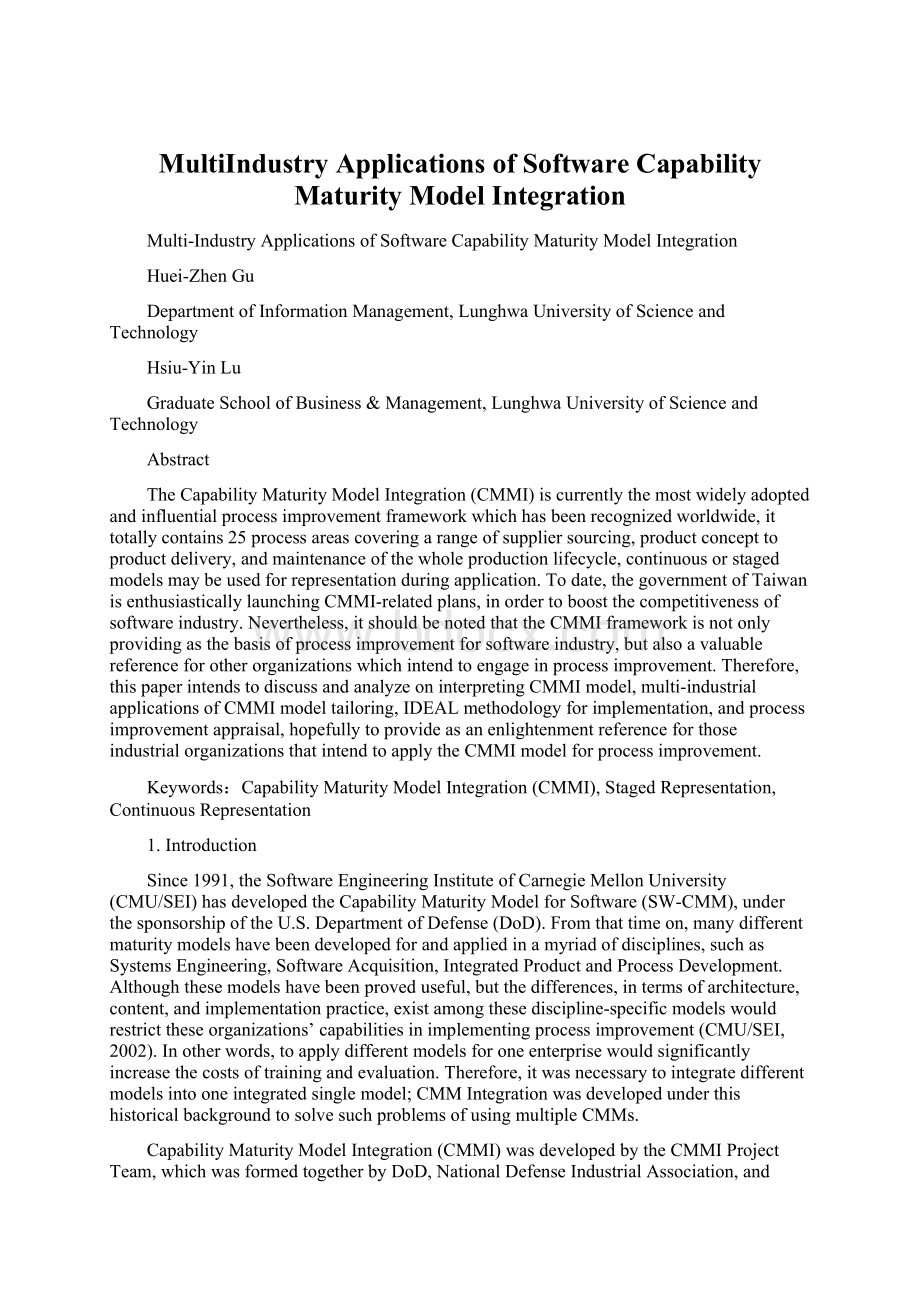MultiIndustry Applications of Software Capability Maturity Model Integration.docx
《MultiIndustry Applications of Software Capability Maturity Model Integration.docx》由会员分享,可在线阅读,更多相关《MultiIndustry Applications of Software Capability Maturity Model Integration.docx(16页珍藏版)》请在冰豆网上搜索。

MultiIndustryApplicationsofSoftwareCapabilityMaturityModelIntegration
Multi-IndustryApplicationsofSoftwareCapabilityMaturityModelIntegration
Huei-ZhenGu
DepartmentofInformationManagement,LunghwaUniversityofScienceandTechnology
Hsiu-YinLu
GraduateSchoolofBusiness&Management,LunghwaUniversityofScienceandTechnology
Abstract
TheCapabilityMaturityModelIntegration(CMMI)iscurrentlythemostwidelyadoptedandinfluentialprocessimprovementframeworkwhichhasbeenrecognizedworldwide,ittotallycontains25processareascoveringarangeofsuppliersourcing,productconcepttoproductdelivery,andmaintenanceofthewholeproductionlifecycle,continuousorstagedmodelsmaybeusedforrepresentationduringapplication.Todate,thegovernmentofTaiwanisenthusiasticallylaunchingCMMI-relatedplans,inordertoboostthecompetitivenessofsoftwareindustry.Nevertheless,itshouldbenotedthattheCMMIframeworkisnotonlyprovidingasthebasisofprocessimprovementforsoftwareindustry,butalsoavaluablereferenceforotherorganizationswhichintendtoengageinprocessimprovement.Therefore,thispaperintendstodiscussandanalyzeoninterpretingCMMImodel,multi-industrialapplicationsofCMMImodeltailoring,IDEALmethodologyforimplementation,andprocessimprovementappraisal,hopefullytoprovideasanenlightenmentreferenceforthoseindustrialorganizationsthatintendtoapplytheCMMImodelforprocessimprovement.
Keywords:
CapabilityMaturityModelIntegration(CMMI),StagedRepresentation,ContinuousRepresentation
1.Introduction
Since1991,theSoftwareEngineeringInstituteofCarnegieMellonUniversity(CMU/SEI)hasdevelopedtheCapabilityMaturityModelforSoftware(SW-CMM),underthesponsorshipoftheU.S.DepartmentofDefense(DoD).Fromthattimeon,manydifferentmaturitymodelshavebeendevelopedforandappliedinamyriadofdisciplines,suchasSystemsEngineering,SoftwareAcquisition,IntegratedProductandProcessDevelopment.Althoughthesemodelshavebeenproveduseful,butthedifferences,intermsofarchitecture,content,andimplementationpractice,existamongthesediscipline-specificmodelswouldrestricttheseorganizations’capabilitiesinimplementingprocessimprovement(CMU/SEI,2002).Inotherwords,toapplydifferentmodelsforoneenterprisewouldsignificantlyincreasethecostsoftrainingandevaluation.Therefore,itwasnecessarytointegratedifferentmodelsintooneintegratedsinglemodel;CMMIntegrationwasdevelopedunderthishistoricalbackgroundtosolvesuchproblemsofusingmultipleCMMs.
CapabilityMaturityModelIntegration(CMMI)wasdevelopedbytheCMMIProjectTeam,whichwasformedtogetherbyDoD,NationalDefenseIndustrialAssociation,andCMU/SEI.Todate,CMMIofferedfourdisciplinesasthereferenceframeworkofprocessimprovementincluding,SystemsEngineering(SE),SoftwareEngineering(SW),IntegratedProductandProcessDevelopment(IPPD),andSupplierSourcing(SS).
Nowadays,CMMIisaninternationallyrecognizedandwidelyusedprocessimprovementframeworkthathasprovidedsystems/softwareorganizationswithsustainedimprovementinsoftwaredevelopmentandmanagementcapability,enhancedtheirsoftwareproductivityandquality,andboostedtheircompetitiveness(Chrissiset.al.,2003).In2004,CMU/SEIperformedaninvestigationamong13companieswhichimplementedCMMIprocessimprovement,anditwasfoundthatallofthesecompaniesgainedimprovementsonaspectsofcost,scheduling,productivity,productquality,customersatisfactionandreturnofinvestment.
Amongtheinvestigationonthese6aspects,thecostaspectisshownwithhigherbenefitof83%,whilethelowestbenefitisenhancedby5%;theschedulingaspectisshownwithhigherbenefitof95%,whilethelowestbenefitisenhancedby15%;theproductivityaspectisshownwithhigherbenefitof60%,whilethelowestbenefitisenhancedby11%;theproductaspectisshownwithhigherbenefitof72%,whilethelowestbenefitisenhancedby20%;thecustomersatisfactionaspectisshownwithhigherbenefitof55%,whilethelowestbenefitisenhancedby10%;thereturnofinvestmentaspectisshownwithhigherbenefitof13timesthanbefore,whilethelowestbenefitisenhancedbydouble.Therefore,thegovernmentofTaiwanisactivelylaunchingCMMIplans,andencouragingmanysoftwareservicecompaniestoobtainCMMIcertification,inordertoboosttheirR&Dcapabilitiesinsoftwaredevelopment.
Fromtheillustrationabove,itisreflectingthattheprocessimprovementofCMMIwouldactuallyresultinquiteremarkableoutcome.Although,CMMIwasinitiallydesignatedonlyforsoftwareindustry,but,afterthoroughunderstanding,itiseventuallyalsoverysuitableforotherindustries.However,accordingtoLin(Lin,2004),"CMMIframeworkshouldnotbemisunderstood,itispurelyandsimplyamanagementtoolfororganizationalprocessimprovementandthisframeworkisnotconfinedtosoftwareindustryorganizationsorsoftwareproductssuchasdigitalcontents,games,customizedsoftwareorCOTS(CommercialOffTheShelf).Inaddition,CMMIcontainssomeofthebestpatternsforengineeringandengineeringmanagement.Whenappliedproperlyandeffectively,itwouldmultiplyproductqualityandalloworganizationtoreceivebenefitsonpursingexcellenceandperpetualgrowth."However,currently,thereareonlylimitedimplementationmethodologies,relevantresourcesandknowledgeontheapplicationsofotherindustries,anditisfarshortofsuccessfulimplementationcasesfromnon-softwareindustrialorganizations(III,2002).Therefore,thispaperfocusesontheinterpretationoftheCMMImodel,thecrossindustrialapplicationofCMMImodeltailoring,IDEALmethodology,and,therebyextendingitsapplicationsunderlyingtheCMMImodel.Thus,hopefullytoofferasanenlightenmentreferenceforalltheindustrialorganizationsthatintendtoapplytheCMMImodelforprocessimprovement.
2.TheinterpretationoftheCMMImodel
CMMIisdevelopedtoprovideanorganizationwithguidanceforimprovingitsorganizationalprocessesandcapabilitiestomanagedevelopment,acquisition,andmaintenanceofproductsorservices(CMU/SEI,2001).CMMIincorporatesprovenpracticesintoaframeworktohelporganizationevaluateitsmaturitylevel(ML)orprocessareacapabilitylevel(CL),inordertosetprioritiesforprocessimprovement,andthenimplementtheseimprovementactivities.
Inaddition,CMMIcontains"ContinuousRepresentation"and"StagedRepresentation"modeltypes;anorganizationcanchooseitsappropriaterepresentationmodelandprocessimprovementmethodology(MaturityLevelorCapabilityLevel)incompliancewithitsindustrialdemands.Amongthem,"ContinuousRepresentation"supportsprocesscapabilitylevelmethodologywhile"StagedRepresentation"supportsorganizationalmaturitylevelmethodology.
2.1Stagedrepresentation
CMMIstagedrepresentationclassifiesprocessareasintofivematuritylevels(ML)inordertosupportandguideprocessimprovement.Fig.1showsthese5CMMImaturitylevels.ExceptMaturityLevel1,eachmaturitylevelhasafocus:
MaturityLevel2(Managed)focusesonprojectmanagement,MaturityLevel3(Defined)focusesonprocessstandardization,MaturityLevel4(QuantitativelyManaged)focusesonquantitativemanagementprocess,whereasMaturityLevel5(Optimizing)focusesonthecontinuousimprovementoforganizationalprocesses.
Figure1.ThefocusofCMMImaturitylevelsforstagedrepresentation
Source:
CMU/SEI,2002
CMMImaturitylevelsprovideasuggestedsequence;eachmaturitylevelisacriticalparttostabilizingorganizationalprocesses.Onceamaturitylevelisreached,itmeanstheorganization’sprocessingcapacityisenhanced.ExceptMaturityLevel1,alltheothermaturitylevelsarecomposedofmultipleprocessareas,andtheentireCMMImodelprovidesanimprovementpathtofollow(CMU/SEI,2002).ThecomponentsofthisstagedrepresentationframeworkareshowninFig.2,whereastheircorrespondingprocessareas(PAs)areshowninTable1.
Figure2Structuralcomponentialdiagramofthematuritylevelsforstagedrepresentation
Source:
CMU/SEI,2002
Table1.SynopsisofmaturitylevelsandtheircorrespondingPAs
Level
Focus
ProcessAreas
Level5Optimizing
ContinuousProcessImprovement
OrganizationalInnovationandDeployment(OID)
CausalAnalysisandResolution(CAR)
Level4QuantitativelyManaged
QuantitativeManagement
OrganizationalProcessPerformance(OPP)
QuantitativeProjectManagement(QPM)
Level3Defined
ProcessStandardization
RequirementsDevelopment(RD)
TechnicalSolution(TS)
ProductIntegration(PI)
Verification(VER)
Validation(VAL)
OrganizationalProcessFocus(OPF)
OrganizationalProcessDefinition(OPD)
OrganizationalTraining(OT)
IntegratedProjectManagement(IPM)
RiskManagement(RSKM)
IntegratedTeaming(IT)
DecisionAnalysisandResolution(DAR)
OrganizationalEnvironmentforIntegration(OEI)
Level2Managed
BasicProjectManagement
RequirementsManagement(REQM)
ProjectPlanning(PP)
ProjectMonitoringandControl(PMC)
SupplierAgreementManagement(SAM)
MeasurementandAnalysis(MA)
ProcessandProductQualityAssurance(PPQA)
ConfigurationManagement(CM)
Level1Initial
Source:
CMU/SEI,2002
2.2ThecharacteristicsofmaturitylevelsofStagedRepresentation
StagedRepresentationisconsistedof5maturitylevelsandtheirunderlyingmeaningsarestatedbelow:
1.MaturityLevel1:
Initial
Atmaturitylevel1,processesareusuallyadhocandchaoticandtheorganizationusuallydoesnotsupportastableenvironment;successintheorganizationdependsonpersonalcompetenceandheroics.Consequently,unlesst